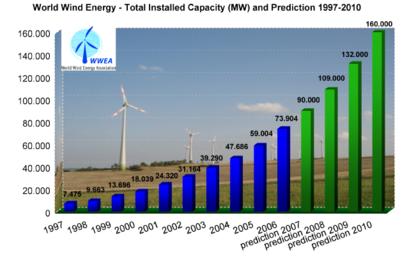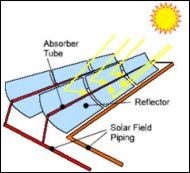Renewable energy commercialization: Difference between revisions
adding image |
→Market considerations: adding image |
||
| Line 15: | Line 15: | ||
==Market considerations== |
==Market considerations== |
||
[[Image:CIS Tower.jpg|thumb|200px|The [[CIS Tower]], [[Manchester]], [[England]], was clad in PV panels at a cost of £5.5 million. It started feeding electricity to the [[national grid]] in November 2005.]] |
|||
First-generation technologies are most competitive in locations with abundant resource endowment. Their future use depends on the exploration of the |
|||
remaining resource potential, particularly in developing countries, and on overcoming challenges related to the environment and social acceptance. For example, there are several significant environmental disadvantages of large-scale hydroelectric power systems, which include: dislocation of people living where the reservoirs are planned, release of significant amounts of carbon dioxide at construction and flooding of the reservoir, and disruption of aquatic ecosystems and birdlife. Hydroelectric power is now more difficult to site in developed nations because most major sites within these nations are either already being exploited or may be unavailable for these environmental reasons (See [[Hydroelectricity]] article for details). |
First-generation technologies are most competitive in locations with abundant resource endowment. Their future use depends on the exploration of the remaining resource potential, particularly in developing countries, and on overcoming challenges related to the environment and social acceptance. For example, there are several significant environmental disadvantages of large-scale hydroelectric power systems, which include: dislocation of people living where the reservoirs are planned, release of significant amounts of carbon dioxide at construction and flooding of the reservoir, and disruption of aquatic ecosystems and birdlife. Hydroelectric power is now more difficult to site in developed nations because most major sites within these nations are either already being exploited or may be unavailable for these environmental reasons (See [[Hydroelectricity]] article for details). |
||
Markets for second-generation technologies are strong and growing, mainly in countries such as Germany, Spain, the United States, and Japan. The challenge is to broaden the market base to ensure continued rapid growth worldwide. Strategic deployment in one country not only reduces technology costs for users there, but also for those in other countries, contributing to overall cost reductions and performance improvement.[http://www.iea.org/textbase/papers/2006/renewable_factsheet.pdf] |
Markets for second-generation technologies are strong and growing, mainly in countries such as Germany, Spain, the United States, and Japan. The challenge is to broaden the market base to ensure continued rapid growth worldwide. Strategic deployment in one country not only reduces technology costs for users there, but also for those in other countries, contributing to overall cost reductions and performance improvement.[http://www.iea.org/textbase/papers/2006/renewable_factsheet.pdf] |
||
Revision as of 00:09, 3 April 2007
| Part of a series on |
| Renewable energy |
|---|
 |
Renewable energy technologies are essential contributors to the energy supply portfolio as they contribute to world energy supply security, reducing dependency on fossil fuel resources, and provide opportunities for mitigating greenhouse gases.[1]
According to the International Energy Agency, it is possible to define three generations of renewable energy technologies, reaching back more than 100 years:[2]
- First-generation technologies emerged from the industrial revolution at the end of the 19th century and include hydropower, biomass combustion, and geothermal power and heat. Some of these technologies are still in widespread use.
- Second-generation technologies include solar heating and cooling, wind power, modern forms of bioenergy, and solar photovoltaics. These are now entering markets as a result of research, development and demonstration (RD&D) investments since the 1980s. The initial investment was prompted by energy security concerns linked to the oil crises of that period but the enduring appeal of renewables is due, at least in part, to environmental benefits. Many of the technologies reflect revolutionary advancements in materials.
- Third-generation technologies are still under development and include advanced biomass gasification, biorefinery technologies, concentrating solar thermal power, hot-dry-rock geothermal power, and ocean energy. Advances in nanotechnology may also play a major role.[3]
First- and second-generation technologies have entered the markets, and third-generation technologies heavily depend on long term RD&D commitments, where the public sector has a role to play.[4]
Market considerations

First-generation technologies are most competitive in locations with abundant resource endowment. Their future use depends on the exploration of the remaining resource potential, particularly in developing countries, and on overcoming challenges related to the environment and social acceptance. For example, there are several significant environmental disadvantages of large-scale hydroelectric power systems, which include: dislocation of people living where the reservoirs are planned, release of significant amounts of carbon dioxide at construction and flooding of the reservoir, and disruption of aquatic ecosystems and birdlife. Hydroelectric power is now more difficult to site in developed nations because most major sites within these nations are either already being exploited or may be unavailable for these environmental reasons (See Hydroelectricity article for details).
Markets for second-generation technologies are strong and growing, mainly in countries such as Germany, Spain, the United States, and Japan. The challenge is to broaden the market base to ensure continued rapid growth worldwide. Strategic deployment in one country not only reduces technology costs for users there, but also for those in other countries, contributing to overall cost reductions and performance improvement.[5]

Some of the second-generation renewables, such as wind, have high potential and have already realised relatively low production costs. At the end of 2006, worldwide capacity of wind-powered generators was 74,223 megawatts, and although it currently produces less than 1% of world-wide electricity use, it accounts for approximately 18% of electricity use in Denmark, 9% in Spain, and 7% in Germany. Globally, wind power generation more than quadrupled between 2000 and 2006. However, issues of seasonal variability present a challenge to their grid integration. In such cases, first-generation technologies, such as hydropower, can serve to level out variable sources. Together with grid improvements and more advanced load and generation management, it is reasonable to assume that renewables will form part of a much more advanced electricity supply structure in the future (see Wind Power article).

Third-generation technologies are not yet widely demonstrated or have limited commercialization. Many are on the horizon and may have potential comparable to other renewable energy technologies, but still depend on attracting sufficient attention and RD&D funding. However, solar thermal power stations have been successfully operating in California commercially since the late 1980s, including the largest solar power plant of any kind, the 350 MW Solar Energy Generating Systems. Nevada Solar One is another 64MW plant which is about to open. Other parabolic trough power plants being proposed are two 50MW plants in Spain (see Solar power in Spain), and a 100MW plant in Israel.[6]
See also
- Photovoltaics
- Renewable energy
- Renewable energy commercialization in Australia
- Renewable energy in Germany
- Solar cell
- Solar power plants in the Mojave Desert
- Solar power tower
- Solar power in Spain
- Wind power
- Wind power in Spain
- Wind power in Germany
- Wind power in Australia
